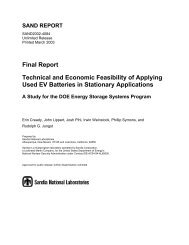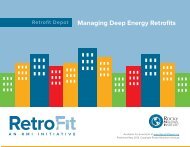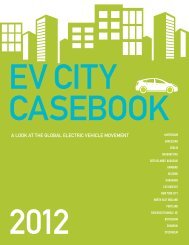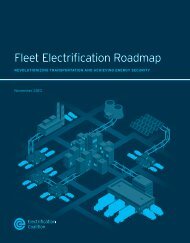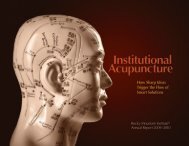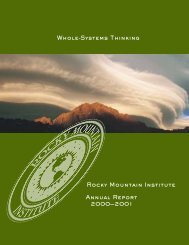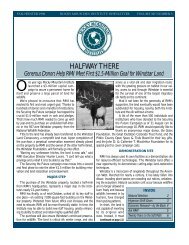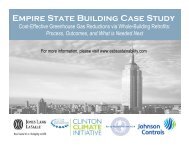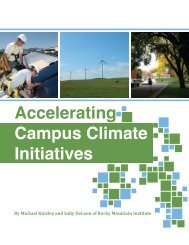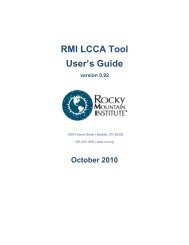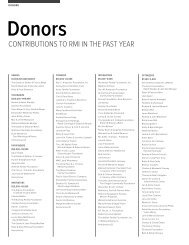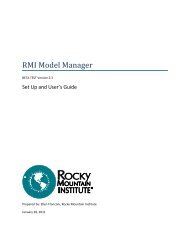Rocky Mountain Institute Annual Report 2002â03
Rocky Mountain Institute Annual Report 2002â03
Rocky Mountain Institute Annual Report 2002â03
- No tags were found...
Create successful ePaper yourself
Turn your PDF publications into a flip-book with our unique Google optimized e-Paper software.
<strong>Rocky</strong> <strong>Mountain</strong> <strong>Institute</strong> <strong>Annual</strong> <strong>Report</strong> 2002–03
Table of Content sOur Mission . . . . . . . . . . . . . . . . . . . . . . . . . . . . . . . . . . . . . . . . . . 3Letter from the CEO . . . . . . . . . . . . . . . . . . . . . . . . . . . . . . . . . . . 6Letter from the Executive Director . . . . . . . . . . . . . . . . . . . . . . . 8Research & Consulting . . . . . . . . . . . . . . . . . . . . . . . . . . . . . . . . 10What RMI’s Supporters and Staff Created Together . . . . . . 11Communications Department . . . . . . . . . . . . . . . . . . . . . . . . . . 20Letter from the Financial Director . . . . . . . . . . . . . . . . . . . . . . 22Financials . . . . . . . . . . . . . . . . . . . . . . . . . . . . . . . . . . . . . . . . . . . 23RMI Supporters . . . . . . . . . . . . . . . . . . 24RMI Board of Directors . . . . . . . . . . . 32RMI Alumni/ae . . . . . . . . . . . . . . . . . . . 34RMI Staff . . . . . . . . . . . . . . . . . . . . . . . . 35RMI’s 4,000-square-foot headquarters in Old Snowmass, Colorado was built as a state-of-the-artshowcase of efficiency techniques, which, far from requiring sacrifice, actually increase comfortand enjoyment while saving money and resources. The building has no conventional heatingsystem (it relies on the clever application of centuries-old passive-solar techniques, superinsulation,and high-tech superwindows) and, although it is now more than twenty years old, stilloutperforms its design, growing 28 passive-solar banana crops so far (at 7,100 feet elevation) andselling surplus electricity back to the grid.
Mission<strong>Rocky</strong> <strong>Mountain</strong> <strong>Institute</strong> (RMI) is an independent, entrepreneurial, nonprofit appliedresearch center that fosters the efficient and restorative use of natural, humanand other capital to make the world secure, just, prosperous, and life-sustaining.We do this by inspiring business, civil society, and governmentto design integrative solutionsthat create true wealth.3
<strong>Rocky</strong> <strong>Mountain</strong> <strong>Institute</strong>’s RMIQ (Q = Quest for Solutions) lecture series confronts the world’smost pressing issues, from global climate change to American energy insecurity.Individually or in panels, transdisciplinary experts describe humankind’s toughest challenges and offerinnovative, profitable solutions. Solving for pattern, with rigorous analysis and original synthesis,RMI’s thought leaders offer new answers to old questions and show their attractiveness acrossideological boundaries. RMIQ’s public lectures and conversations are presented in various Aspen,Colorado venues in summer, winter, and spring.4
Letter from the CEO6
Open here.7
Letter from the Executive DirectorIn the past year, RMI has not onlyturned around its financial health (inthe midst of a war and tough economy),but has hit its stride in attractingthe right people to do its work. Weaggressively seek individuals whoare not only the best in their fields,technical or otherwise, we seek peoplewho have rich life experience. Weseek people who are literate, numerate,self-starting, fun, intensely curious,integrative, and transdisciplinary— and we get them. Besides staffmembers, we’ve also sought someof the best and brightest in their fieldsto collaborate with RMI in our newsenior fellows program.Now I’m going to brag a little aboutour latest brainpower.Kyle Datta first came to RMI as ayoung man, and used his trainingwith John Todd to design our headquarters’greenhouse aquaculture.Several degrees from Yale and extensiveconsulting experience (leadingthe U.S. utilities practice at BoozAllen & Hamilton) later, Kyle hasreturned as the Managing Director ofour Research and Consulting group.Amory’s special aide, Olympic rowerOdd-Even Bustnes, holds Oxford andPrinceton master’s degrees in engineeringand economics, respectively,8and brings deep energy and policyknowledge (after working withMcKinsey & Company) to RMI’sResearch and Consulting group.Our newest staff engineer Kitty Wang,PE, a member of RMI’s Energy &Resources Team, brings strong experiencein energy efficiency, plant constructionmanagement, and carbonmanagement from her years in thepower utility sector.Karen Nozik joined RMI in the springas our Communications Director andhas extensive Capitol Hill experienceand marketing savvy. When theNortheast blackout occurred, severaljournalists mentioned that they hadRMI’s press release on their desksbefore the news reached the papers.RMI’s senior fellows are some remarkablyexperienced people. JonathanKoomey, Ph.D., a former staff scientistat Lawrence Berkeley NationalLaboratory and author of TurningNumbers into Knowledge, bringsworld-class energy end-use experienceto RMI. Already he has been animportant collaborator on severalkey projects. Bob Wilkinson, Ph.D.,a lecturer in the EnvironmentalStudies Program at the University ofCalifornia, Santa Barbara (and Chairmanof Earth Island <strong>Institute</strong>), hasworked with RMI for many years.As a senior fellow, he brings expertisein water, energy, environment, andresource issues. With a distinguished35-year military career rising toDeputy Chief of Naval Operations,Vice Admiral Denny McGinn (USNRet.) recently joined RMI as a seniorfellow in International Security.Another valued senior fellow isCommander Eric Rasmussen (USN),MD, FACP, former Fleet Surgeonwith the U.S. Navy’s Third Fleet.Eric now works on medical supportfor humanitarian operations (he wasphysician coordinator for the IraqHumanitarian Operations Centerin Kuwait during the war in Iraq),and serves as a principal investigatorfor the Defense Advanced ResearchProjects Agency (DARPA) and theNational Science Foundation.With the recent war in Iraq andAmerica’s ongoing reliance on foreignoil, security is near the top of our“to do” list. Both Denny and Ericare ensuring that RMI’s workis being heard and appliedby America’smilitary leaders.
This brainpower, along with our otherbright and talented staff, is advancingRMI in the business, government, andmilitary arenas as never before. Overthe past twelve months, RMI broughtits expertise into leading utilities andenergy firms; developed a new andsuperefficient design for data centers;and as usual helped to design numerousgreen buildings through ourGreen Development Services team.So exactly how do our people integratetheir skills and experiences for clients?Let me give you a few examples.Unlike most consulting organizationsthat might hire an engineer for hisor her skills with HVAC equipment,we hire engineers whose HVACequipment skills are superb and whocan then sit down and talk to thebuilding’s owner about internal rateof return, electric grid vulnerability,and fuel cells — and then explainhow getting rid of the HVAC systemaltogether is the safest (and cheapest)way to avoid system failures.When RMI works with a communityon renewable energy systems, wenot only produce recommendationsappropriate to climate, economics,and physical settings, we explore andexplain why retiring old energysystems is so important. Things like“environmental justice” (e.g., shuttingheavily polluting fossil-fuel powerplants in minority neighborhoods) andboosting wind turbine manufacturingaren’t always on the minds of governmentbureaucrats planning energysystems — yet they should be.If we are approached by military leaderslooking to integrate humanitarianactivities into nation rebuilding, RMIstaff members don’t offer only technologicaland deployment suggestions;we delve deep into societal and politicalissues to make sure the technologiesdon’t collide with cultural mores.It’s this kind of broad thinking thatmakes RMI different from any otherorganization. In the next eight pages,you’ll get a sampling of our cross-specialtywork, but I encourage you toexplore it further at www.rmi.org,where challenges from engineering,architecture, business management,medicine, community economicdevelopment, national security, andof course energy are tackled by specialcombinations of unusual people.With the ongoing crises in worldsecurity and in energy supplies andsystems, and the growing awarenessthat resources are typically cheaperto save than to buy, you can expect tosee a lot more top-drawer experts,either on staff or working closely withRMI, in the years to come. The importanceof our work demands that ourpeople be as talented and well-integratedas our issues are challenging.Martha C. Pickett, Esq.Executive DirectorRMI staff members and our associates come from diverse backgrounds and bring a wide rangeof experiences to our mission. Such broad knowledge enhances projects as complex asgreening up the military and as simple as taking downthe large Aiki tent, near RMI's Southeast Annexin Old Snowmass.9
Research & ConsultingCatalysts for Transformational ChangeResearch and consulting has a pervasive influence in our everyday lives: the water we drink,the energy we use, the buildings we live in, the cars we drive, the places we work.We serve society as catalysts for transformative change, using innovative ideas to unleashthe creative forces within our clients, enabling them to achieve results.Helping clients achieve tangible results requires building enduring relationships over severalyears to shepherd the ideas from inception to fruition.RMI has built such relationships withpublic and private leaders includingRoyal Dutch/Shell, The Coca-Cola Company,Invensys, BC Hydro, SuperValue,Interface, the City of San Francisco, the California Academy of Sciences,the Bronx Zoo, and Battle McCarthy among others.These ongoing relationshipsare testimony to the value created by RMI’sconsulting services. They also underliethe financial success of the research and consulting team,which this past year exceeded its financialperformance targets.10
Our consulting activities are not an end unto themselves,but rather a vehicle to further RMI’s mission by applying our research insights in realworld contexts.Research and Consulting is organizedinto three teams,each with its own mission.What RMI’s Supporters and Staff Created TogetherAlthough the <strong>Institute</strong> was founded in 1982,RMI’s intellectual contributions span more than three decades.In the boxes on the following nine pages we present our most notable achievements.11
Research & ConsultingEnergy & Resources Services“In mid-July, with the help of <strong>Rocky</strong> <strong>Mountain</strong> <strong>Institute</strong> (RMI), BC Hydro conducted an internal workshop on ‘VancouverIsland’s Energy Future.’ The specific purpose of the workshop was to identify and prioritize sustainable energy options formeeting future energy service needs on Vancouver Island.These options had to demonstrate least-lifecycle cost and risk,within the framework of the BC energy policy (low electricity rates, secure and reliable supply, more private sectoropportunities, environmentally responsible, and no nuclear power) and of existing transmission, generation, and fuel supplyoptions.The workshop focused on the longer-term energy service needs of Vancouver Island, and the results will be used byBC Hydro in its deliberations on an Integrated Electricity Plan (IEP).The attraction of having RMI put on this workshopwas the approach the <strong>Institute</strong> takes. RMI’s workshops result in innovative solutions because participants can set asideday-to-day office concerns, explore important issues with colleagues with whom they don’t normally work and set asidenormal caution about what can be suggested. Spontaneity and unorthodox ideas are encouraged and participants work withthe whole system, not just the portion for which they are responsible every day. I was very impressed with how the daywent and believe the results will help us move forward with our Integrated Electricity Plan.”— Larry Bell, Chairman, BC Hydro1970s: What RMI’s Supporters and Staff Created Together1972– • Invented most of the ways now in use for making markets in saved electricity and other resources (energy)1975–2002 • Showed how “distributed benefits”make decentralized electric resources as much as ten times more valuable (Small IsProfitable, www.smallisprofitable.org) (energy)1977– • Helped 18 heads of state understand the links between efficiency and security, environment and prosperity (energy)• Laid most of the conceptual and technical foundations for the multi-billion-dollar “negawatt”(electric-efficiency) industry (energy)• Showed how to eliminate oil insecurity at a profit, and in 1988–89, how to save ~80% of U.S. oil use for a few dollars per barrel (security)1978–83 • Formulated the first internally consistent approach to nuclear nonproliferation, lately vindicated (Energy/War: Breaking the NuclearLink,“Nuclear Power and Nuclear Bombs”[Foreign Affairs ], The First World Nuclear War ), including the first unclassified but convincingdemonstration of the proliferative risks of reactor-grade plutonium and of thorium fuel cycles (security)12
TransformingEssential InfrastructureThe recent blackout in the EasternUnited States and Canada is a dramaticexample of the fragility of ournation’s infrastructure that RMI firsthighlighted in 1982 with its publicationof Brittle Power: Energy Strategyfor National Security. RMI’s solutionis to create a more resilient lower-costsystem by complementing improvementsin the grid with a low-costcombination of energy efficiency,demand response, and distributedgeneration. While RMI’s policy outreachis active on the federal level,the real action occurs in the states,where implementation happens.For the past two years, Energy &Resources team leader Joel Swisherand engineer Kitty Wang have beenworking with the City of San Franciscoto develop an Energy ResourceInvestment Strategy that will makeSan Francisco the largest municipalproducer of renewable energy,at lower cost and less risk that fossilfuelalternatives, while improvingthe system’s reliability. When RMI firststarted working with the City in 2001,Mirant’s large gas-fired plant and amajor new transmission line werewidely accepted as the only crediblechoices. By 2003, Mirant was bankrupt,the transmission line had inadequatepublic support, and RMI’s planwas being implemented.RMI is now bringing these insightsto other utilities, such as BC Hydro,whose challenging power situation onVancouver Island may become criticalunless new resources are adopted.Fortunately, RMI had already led theutility’s exploration of faster, cheaper,and more resilient alternatives and aproposed gas-fired plant has just beenrejected by regulators as not least-cost.Competitive power markets aresubject to inefficiency and abusebecause there has traditionally beenno way for customers to respond toprice. Demand response means signalingcustomers when power is scarce,so they can choose convenient waysto trim or defer power use. Seeing thesavings, industrial customers havebeen quick to adopt demand response.But conventional wisdom is thatsmart meters and control technologiesare too expensive for residentialcustomers, who are often the greatestcontributors to peak power requirements.RMI has been working in partnershipwith Invensys and forwardlookingutilities such as PECO andNevada Power, to demonstrate thatthe full distributed benefits of demandresponse make it cost-effective.early 1980s: What RMI’s Supporters and Staff Created Together1981– • Reframed the debate by showing academics and CEOs that climate protection is profitable, not costly, because saving fuel is cheaperthan buying fuel (Least-Cost Energy: Solving the CO 2 Problem,“Least-Cost Climatic Stabilization”) (climate)1981–88 • Showed how nuclear power worsens global warming compared to better buys (climate)1982– • Designed, constructed, and showed to over 70,000 visitors one of the world’s most efficient and well-integrated buildings (paid forprivately) (buildings and land) • Prepared for the Pentagon what is still the definitive unclassified study of domestic energy vulnerability, andhow to make energy systems inherently resilient at a profit (Brittle Power: Energy Strategy for National Security, reposted in 2001), then appliedits lessons to U.S. blackout prevention and to Iraqi energy systems resistant to asymmetric warfare (security) • Conceptually linked military, economic,and environmental security (security) • Gave hundreds of business presentations and broadcasts on profitable climate protection andadvanced resource productivity (business innovation) • Developed compelling experience in such industries as electricity, hydrocarbons, chemicals,water, food and beverage, forest products, mining, semiconductors, electronics, general manufacturing, and automotive through detailed technicalconsultancy around the world, recognized in 2002 alone in a six-page feature in Fortune and others in Time and Esquire (business innovation)13
Research & ConsultingCommercial & Industrial Services“RMI’s far-sighted thinking on energy technology is always challenging and occasionally inspired. It continues to help ussharpen our business strategy and find profitable new ways to respond to the global energy challenge.The Factor 4 pilot [project]s we are doing with Amory and RMI are helping us raise our game on energy efficiency.They bring Shell people face to face both with the environmental and financial savings possible through eco-efficiency.”— Mark Weintraub, Head of Sustainable Development Strategy, Policy & <strong>Report</strong>ing, Royal Dutch/Shellearly 1980s (continued): What RMI’s Supporters and Staff Created Together1982– • Laid the groundwork for a “soft water path”— ways to provide the same or better services with less water and usually with less, smaller,and cheaper infrastructure — and, as with energy,“wrote the book”on water-efficient technologies and their implementation (1987– ), thenco-led their institutionalization (water) • Provided technical and strategic consultancy for more than 65 of the Fortune 500, including several ofthe world’s 50 leading brands (business innovation) • Provided pro bono analysis and testimony to help get several uneconomic dams cancelled,including the major Two Forks and Big “A”dams, and to help water-short communities substitute cheap efficiency for costly supply (water)1983–99 • Systematized design methods that make big savings cheaper than small ones, thus “tunneling through the cost barrier”(NaturalCapitalism) (energy)9 late 1980s1985– • Created Economic Renewal, an innovative process and toolkit for promoting sustainable local economies, equipped it with topical casebooksand workbooks, and refined it in more than 20 community field trials (community economic development)1985– • Helped dozens of communities around the world find alternatives to indiscriminate growth, sprawl, and resource-dependent economies(community economic development)1986 • Created E SOURCE, spun it off in 1992, and sold it in 1999 to the Financial Times group; it’s the world’s leading technical informationservice on electric efficiency (www.esource.com) (energy)1986–94 • Researched conventional beef-raising practices and the favorable economics of organic agriculture (farming and forestry)1988–99 • Codified integrated transportation policy innovations to reduce driving (transportation)9 early 1990s1990–91 • Invented the Hypercar ® concept, which could ultimately save as much oil as OPEC now sells, makes light vehicles ready for directhydrogenfuel cells, unlocks the hydrogen economy, and can profitably deal with up to two-thirds of the climate challenge (transportation)• Founded Green Development Services, a leader in moving the real estate industry toward restorative design (buildings and land)1991 • Presciently analyzed in The Atlantic,“The Avoidable Oil Crisis”(energy)14
Making Sustainability RealMany corporations talk about sustainability,but fewer have taken thetangible steps to bring lofty abstractionsdown to decisions on the factoryfloor. The Commercial and IndustrialServices team does just that, workingwith plant managers at industrialfacilities to integrate whole-systemthinking into the manufacturingprocess to lower costs and reduce,or better, eliminate environmentalimpact. Over the last year, Commercial& Industrial Services’ teamleader Catherine Greener and engineerJason Denner have traveledacross the United States, Europe, andAustralia working in a wide varietyof industrial settings including oilrefineries, chemical facilities, bottlingplants, an offshore platform, anLNG plant, and even a yogurt plant.In each case, RMI’s “Innovation Lab”consulting process has been able touncover untapped resource savingsof 30–50%, with after-tax return oninvestment around 12–30% per year.More importantly, the tangible improvementsat the plant that “green thebottom line” have engendereda cultural shift towards adoptingsustainability principles and integrativeengineering design throughoutthe corporation.For the past two years, RMI has beenin partnership with Royal Dutch/Shell’s internal consultancy, ShellGlobal Solutions, to bring RMI’sinsights on radical resource efficiencyto Shell facilities around the world.In every case, RMI has demonstrateda surprisingly unexpected potential forsignificant cost-effective savings.RMI has developed a similar relationshipwith The Coca-Cola Company;RMI has toured bottling facilitiesacross the Coca-Cola system todemonstrate the value of natural capitalismprinciples in the manufacturingcontext. In both cases, our client’scorporate objective has been thesame: incorporating natural capitalisminto the manufacturing processescan become the new wayto do business.1991, 2001–2002 • Helped spare the Arctic National Wildlife Refuge from oil extraction by exposing the proposal’s fatal national-security andeconomic flaws (energy)1991– • Developed the least-cost security thesis of Security Without War (1993/2000) and its new strategic triad — conflict avoidance or prevention,conflict resolution, and nonprovocative defense — then injected them into military discourse via lectures at the Naval War College, NavalPostgraduate School, and National Defense University (security) • Helped design several hundred showcase projects, including skyscrapers,retail spaces, affordable housing, convention centers, the Sydney Olympic Village, and the Greening of the White House (buildings and land)• Served on the boards of Greening America, the U.S. Green Building Council (USGBC), and the Trust for Public Land’s National Real EstateAdvisory Council (buildings and land)1991–1997 • Synthesized and published the leading text on a strategy that makes real-estate development a tool for profitably healing naturaland human communities (Green Development: Integrating Ecology and Real Estate), plus a CD-ROM with 100 (1997), then 200 (2001) casestudies(buildings and land)15
Research & ConsultingGreen Development Services“In the final analysis, our planet is our biggest and most fragile resource, and the irony is that we don’t cost for it,we pretend it’s free, so we are not so much living on borrowed time as living on stolen resources.”— Rick Haythornthwaite, CEO Invensysearly 1990s (continued): What RMI’s Supporters and Staff Created Together1991–98 • Co-created with Pacific Gas and Electric Co. a pioneering demonstration (“ACT 2 ”) that most of the energy in new and old buildingscan be cost-effectively saved (buildings and land)1991–99 • Incubated the Hypercar ® concept through a $3-million effort by RMI’s Hypercar Center (transportation)1992–97 • Codified 60–80 market failures in buying efficiency, and ways to turn them into business opportunities (“Climate: Making Sense andMaking Money”) (energy)1993 • Helped establish the LEED (Leadership in Energy & Environmental Design) system for rating green building design (buildings and land)• Introduced the Hypercar concept worldwide to automakers, potential market entrants, policymakers, and the public (transportation)1993–2000 • Helped spur the global auto industry to invest ~$10 billion in ultralight hybrid-electric vehicle development (accelerating it byprobably a decade or more) by putting the Hypercar concept in the public domain, so nobody could patent it, and maximizing competition inexploiting it (transportation)1994 • Wrote an acclaimed do-it-yourself Economic Renewal Guide and trained others in the process, making it self-replicating (community economicdevelopment) • First proved that green buildings valuably boost labor productivity (buildings and land)9late 1990s1995 • First exposed more than $50 billion of annual Federal energy subsidies, leading to their widespread criticism and eventual decline (energy)• Published “Water Efficiency for Your Home”(water)1995–98 • Coordinated the Systems Group on Forests, generating novel insights into profitable ways to reduce pressure on natural forests(farming and forestry)1996 • Developed four scenarios of hypothetical U.S. water futures for EPA (“Water 2010: Four Scenarios for 21st Century Water Systems”) (water)1996–2001 • Predicted grave problems with California’s electricity restructuring, then contributed to diagnosis and correction (energy)1997 • Helped refocus U.S. policy on profitable “barrier-busting”during and after Kyoto (Climate: Making Sense and Making Money) (climate)• Coauthored Factor Four, adopted by the European Union as a new basis of sustainable development (business innovation)1997– • Helped shift U.S. climate leadership to the private sector, accelerating carbon reductions (climate)1998 • Helped design a prototype superefficient office building that is expected to transform the market (buildings and land)16
Charting the Next Frontierin Green DesignTwelve years ago, when RMI launchedGreen Development Services, greendesign was barely known within thearchitecture and engineering community.By 2003, the U.S. Green BuildingCouncil’s Leadership in Energyand Environmental Design ratingsystem, which RMI helped establish,had been adopted for 5% of all theU.S. commercial space currently indesign, and the USGBC has doubledits membership in each of the pastthree years. RMI’s Bill Browning isa founding board member of theUSGBC, and RMI’s Huston Eubankrecently joined the board of thenewly-formed World Green BuildingCouncil. Green Development’s missionis to chart the next frontier forgreen design, expanding the boundariesof what is possible.The goal is to take environmentallysound architecture beyond the currentfocus of resource efficiency to becomeproactively life-enhancing for humanwell being and to promote the longtermrejuvenation of life on earth.Cognizant of the demographic shiftsin society, RMI is taking on the challengesof health care facilities.Although there are several ongoingefforts to “green” these facilities bymaking them more energy-efficient orless polluting, there have been fewefforts to integrate their design, operation,and procurement explicitly withefforts to improve patient health andhospital worker productivity. RMI’sresearch on biophilia, which exploresthe human response to the naturalenvironment, addresses this gap.RMI’s perspective has expandedbeyond anthropocentric views andhas begun to work with other species.Green Development Services teamleader Alexis Karolides, with BillBrowning and Jen Seal, are pioneeringefforts with the Bronx Zoo, theNational Aquarium, the CaliforniaAcademy of Sciences, and the IowaPrimate Learning Sanctuary to designnew interactive exhibits for theanimals who will live in these buildings(and sometimes with the inputof the animals themselves).Given the importance of the Internetto the information economy, andthe pervasive myths about its energyappetite, RMI convened an industryforum to address data centers. HustonEubank led the charrette, which foundthat, using existing technology artfullycombined, data center power needscould be cut 89% at lower capital costsand with greater uptime.1998–1999 • Spun off Hypercar, Inc. (www.hypercar.com) to support the auto industry’s transition to ultralight hybrid-electric vehicles; thispartly-owned subsidiary then designed the world’s first uncompromised, cost-competitive, 99-mpg midsize SUV, raised $9 million of private equity,and developed the patented Fiberforge process for manufacturing carbon-fiber autobodies (transportation)1998–2002 • Overhauled the U.S. Navy’s building design process (security)1998– • Synthesized a highly advantageous approach to advanced electric efficiency in microchip fabrication plants and other industries (energy)• Guided STMicroelectronics, one of the world’s top five chipmakers, in devising profitable paths to its goal of zero carbon emissions by 2010(business innovation)1999 • Coauthored Natural Capitalism, a compelling case for business leaders to create the next industrial revolution (now a U.S. bestseller, winnerof the Shingo Prize, in or entering a dozen languages, and at www.natcap.org) (business innovation) • Devised environmentally restorativeand profitable approaches to the multi-billion-dollar combined sewer overflow problem facing 1,300 U.S. cities and towns, illustrated by low-cost,multi-benefit opportunities for Pittsburgh (“Re-evaluating Stormwater:The Nine Mile Run Model for Restorative Development”) (water)17
Communities,Education, and Outreach“The natural capitalism MBA classes at the University ofColorado’s Leeds School of Business are so far proving veryeffective in helping students change their mental modelsregarding business and environmental performance —helping them recognize that the two do not have to be inopposition to each other. Using the natural capitalism frameworkas a lens in Leeds’ Sustainable Venturing classes, we hope toengage the creative energy of budding entrepreneurs in solvingthe world’s environmental problems-at a profit.”— Professor Thomas J. Dean,Leeds School of Business, University of ColoradoRMI’s Joel Swisher (left) and Bill Browning (right) spread the wordabout fostering the efficient and restorative use of natural capital.late 1990s (continued): What RMI’s Supporters and Staff Created Together1999– • Launched a consulting practice based on natural capitalism, a new organizing framework for RMI’s corporate, small business, and community“applied research”(business innovation) • Published a way, now being adopted, to make the hydrogen economy profitable at each stepstarting now (“A Strategy for the Hydrogen Transition”) (energy) • Developed an influential critique of transgenics and supportedinternational multi-stakeholder dialogues on genomics (farming and forestry) • Experimented with optimal restoration practices for degradedwestern rangeland and for restoration of alpine wetlands (farming and forestry)1999–2001 • Found billions of dollars’ annual energy savings in land, sea, and air platforms during service on a Defense Science Board panel(Enhanced Warfighting Capability Through Reduced Fuel Burden, www.acq.osd.mil/dsb/fuel.pdf) (the first major recommendation, re-enginingB-52s, was unanimously endorsed in 2003 for a $6–9 billion present-valued net saving) (security) • Helped debunk the myth of huge electricityuse by the Internet (energy)early 2000s2000 • Explained the benefits, challenges, and costs of “daylighting”— exposing formerly culverted or buried streams — and developeddozens of U.S. and foreign case-studies (water)2000–01 • Found nearly $1 million of present-valued savings in a typical Aegis cruiser’s “hotel loads”for the Secretary of the Navy, and in2003, proposed their capture fleetwide (security)2000–02 • Devised a plan for Oberlin College in Ohio to achieve net zero greenhouse gas emissions by 2020, by far the most aggressive goalfor any U.S. college or university (climate)18
Integratingthe Whole SystemRMI’s communities program strivesto integrate the principles of wholesystemdesign into the planning ofurban areas and watersheds. Programleader Michael Kinsley’s ongoingefforts in Cleveland’s Cuyahogawatershed are focused on revitalizingthe urban landscape and economythrough the broad application ofnatural capitalism. RMI also partneredwith the EPA to develop the CommunityEnergy Opportunity Finder,a web-based tool to help communitiesdiscover opportunities to improvetheir energy efficiency.RMI’s educational mission has beenrefocused on improving/reforming/transforming the educational curriculumat graduate and professionalschools in engineering, business, andarchitecture. RMI’s Chris Page iscurrently working with the Universityof Colorado’s business school todevelop natural capitalism case-studiesfor MBAs.RMI’s Joel Swisher taught a lectureand project course at StanfordUniversity (where his successor isRMI Senior Fellow Jon Koomey)that introduces tools and methods fordesigning and implementing greenhousegas (GHG) mitigation —including energy efficiency anddemand-side management, distributedpower and cogeneration, green powerand renewable energy development,and carbon sequestration. The coursealso explores relevant policy optionssuch as regulation and carbon taxesand carbon trading, as well as businessstrategies related to GHG management,carbon trading, risk management,and regulatory positioning.Our outreach efforts have been successfulin disseminating our groundbreakingresearch perspective to thebroader community. RMI’s recentwhite paper demystifying the hydrogeneconomy, “20 Hydrogen Myths,”was downloaded a record-breaking30,000 times within its first12 weeks.In summary,RMI’s Research & Consultingteam is changing the worldyou live in, making oursociety more prosperous,durable, and safe.COMMUNITYENERGYO P P O RT U N I T YI N D E RF2001 • Led a major workshop (now being imitated in other regions) on recharging depleted aquifers and managing stormwater and wastewaterin the Chino Basin of Southern California (water)2001–02 • Synthesized more than 20 innovative ways to accelerate the deployment of efficiency and renewable energy without changing taxes,prices, or regulation (energy) • Hosted the Chief of Naval Operations’ Strategic Studies Group and a Naval seminar on network-centric warfare(security) • Co-designed a model Brazilian primary school with beautiful daylighting, 75% electricity savings, and probably faster learning(buildings and land) • Working with the world’s leading humanitarian organizations, the Navy, and the National Science Foundation, redesignedrefugee/displaced-persons camps from scratch, with emphasis on Afghan needs (security)19
Communications DepartmentIf a tree falls in the forest andno one hears it,does it make a sound?The proverbial question serves as a guiding principle for the teamof skilled artists, writers, editors, event producers, list-builders, web-savvytechnicians, administrators, and media specialists who make up RMI’sCommunications Department.early 2000s (continued): What RMI’s Supporters and Staff Created Together2001– • Initiated a major compilation of case studies supporting “biophilia,”the hypothesis that people are healthier, happier, and more productivein naturalistic spaces (buildings and land) • Addressed dozens of meetings of community planning leaders in the U.S. and abroad (communityeconomic development) • Explored with DoD leadership the potential of Hypercar and whole-system design to make military platforms so efficientthat the Pentagon would cease being the world’s largest user of oil (security) • After 9/11, provided influential briefs to military leadershipand articles for the public on least-cost security, asymmetric warfare, critical infrastructure, and strategic doctrine (security) • Led redesignexercises for one of the world’s largest oil companies on how to save over two-fifths of an efficient refinery’s energy use, design a stacklessrefinery, save half of an offshore platform’s energy (and recover the rest from waste), and achieve huge energy and cost savings at a giant liquefied-natural-gasplant (business innovation) • Advised Native American leaders on prudent development of their tribes’ vast renewable energyresources (energy)2002 • Created the National Energy Policy Initiative (www.nepinitiative.org), showing that a consensus-based energy policy process cancommand wide bipartisan support (energy) • Helped EPA apply our Small Is Profitable work on optimal scale to water and wastewater systems,revealing major opportunities to enhance performance and cut cost (water) • Testified in the first-ever U.S. Senate roundtable on green building —applicable to the half-million federal buildings, the nation’s largest “fleet”(buildings and land) • Co-hosted the first International Green BuildingConference (buildings and land) • Published Cool Citizens: Household Solutions (climate) • Published the economic case for early use offuel cells (Cleaner Energy, Greener Profits) (energy)2002–03 • Helped the City of San Francisco develop a comprehensive energy resource investment strategy (ERIS) for its $100+-millionbond issue (energy)2002– • Taught natural capitalism at Peking University, which trains many of China’s future leaders (business innovation)2003 • Published a guide for profitable climate protection for business leaders (The New Business Climate: A Guide to Lower Carbon Emissionand Better Business Performance) (climate) • Helped ~90 computer-industry experts devise a 9×-more-efficient but cheaper design for “serverfarms”(Design Recommendations for High-Performance Data Centers) (energy) • Developed a “Community Energy Opportunity Finder”for communities— an Internet-based do-it-yourself tool for developing wealth, saving resources, and improving quality of life (community economicdevelopment) • In the world’s first known interspecies design project, codesigned the Iowa Primate Leaning Sanctuary with some of its occupants— language-rich bonobos (a Zaïrean great ape) and orangutans — then continued this line of work at the Bronx Zoo and the CaliforniaAcademy of Sciences’s new aquarium (buildings and land) • Demystified the hydrogen economy (“Twenty Hydrogen Myths,”downloaded 30,000times in its first 12 weeks) (energy) • Compiled basic “zingers”about national oil security (“Energy Security Facts”) (energy)2003– • Began assembling a 2004 summer study to write “10XE: Factor Ten Engineering”— the case-study book on how to achieve radicalresource savings at lower cost — and use it to transform how engineering is taught and practiced worldwide (business innovation)• Initiated a major research effort to understand how buildings might mimic natural creatures, systems, and phenomena (biomimicry), and indoing so use less energy and fewer resources (buildings and land)2003–04 • Launched research for Out of the Oil Box: A Roadmap for U.S. Mobilization (energy)∞20
After all, it’s a noisy cluttered worldbeyond our beautiful <strong>Rocky</strong><strong>Mountain</strong>s, and we’d better payattention, lest a tree should falland we don’t hear it. Or worse, RMIfails to make the rest of the worldhear the institute’s message, read itswords, consider its work, or bemoved by its research.Today’s communications systemsare better connected yet more individualized,challenging us to utilizetechnology to its optimum to getheard, read, considered, and ultimately,to make a difference.That’s the CommunicationsDepartment’s job. Whether it’s maintainingour 650-plus-page website,describing complex ideas with easilyunderstood graphics, carefully combingour research documents andreports for accuracy and digestibility,nurturing networking opportunities,building robust contact distributionlists, or letting the media know whenwe’re topical, the global issues aresimply too important, and RMI’s worktoo valuable, to get left on the shelf.CommunicationsDepartmentOur numbers show that we’rebeginning to makea sound.listenwww.rmi.org (fiscal year: 1 July 2002 – 30 June 2003)Audience.com (Commercial) 228,683.net (Network) 218,133.edu (Educational) 42,074.gov (US Government) 11,855.org (Nonprofit Orgs) 7,130.mil (US Military) 5,688Canada (.ca)20,015Country of OriginUnited Kingdom (.uk)13,242www.rmi.org(fiscal year: 1 July 2002 – 30 June 2003)Netherlands (.nl) 4,659France (.fr) 4,355Germany (.de) 3,990Italy (.it) 3,919Japan (.jp)3,245Singapore (.sg)2,537New Zealand (.nz)3,003Australia (.au)16,372Total Visitors810,902 (avg 67,575/month)Total Pageviews4,598,541 (avg 383,211/month)Average Sessions/Day 2,222Average Pageviews/Day 12,599Average Length of Session 09:3821
Letter from the Financial DirectorThe 2002–03 fiscal year was a watershedyear for <strong>Rocky</strong> <strong>Mountain</strong> <strong>Institute</strong>.Changes in personnel, a focus on teammanagement, hiring the right people,and emphasizing results all helped tochange the <strong>Institute</strong>’s financial direction.These changes did not all occur duringthe past year, however. Over the pastseveral years, many changes were madeto improve the <strong>Institute</strong>’s financial andprogrammatic direction. Each of thesechanges, from evaluating the competitivenessof our pay structure to selectinga new enterprise accounting system torevising billing procedures to reviewingmonthly financial statements with ourFinance Committee and team leaders,has contributed to the health ofthe <strong>Institute</strong>.RMI’s internal operations were improvedsignificantly in FY2003. Those changesreflected positively in our financial statements.Revenues grew as a result of thegrowth of our consulting practice, whileexpenses contracted as positions werere-evaluated, contract labor was heldin check, and other expenses weremanaged on a project-by-project basis.The result is an operating marginof $546,000, compared to a deficit of$(696,000) FY2002, a $1.2-millionturnaround.Operating revenues increased by 20%,from $4.9 million to $5.9 million,caused by a 90% increase in our consultingengagement revenues (from $1.38million to $2.62 million). Contributionsfrom individuals rose by 8.6%, our bestyear ever, while foundation grants werevirtually unchanged at $1.6 million.While our consulting revenuesincreased, our expenses actuallydeclined, from $5.6 million to $5.33million. This reduction was primarilyin our payroll. Over the past two yearswe have analyzed each of our departmentsand teams and have reconfiguredour staffing to reflect current needs.The result is a reduction of approximatelyten positions, costing approximately$500,000. Contract labor alsodecreased, from 60% of operating revenuesin 2002 to 33% in 2003, a resultof our efforts to manage projects andproject margins. Numerous otherchanges were made, including institutinga debit card system for accountingfor travel by person and by project.We did suffer investment losses in thesummer of 2002. Our funds are heldin a conservative portfolio, with 70% inequities and 30% in fixed-income securities.In September 2002 we hired aprofessional investment manager for ourportfolio, Ryan Investment Management,LLC. Since then, for the last nine monthsof our fiscal year, the net return on ourportfolio was 11.51%.Our total cash and investments dropped$835,000, reflecting our book loss andchanges in working capital. Other assetsremained relatively unchanged. Our currentliabilities dropped $320,000, andlong-term liabilities dropped $124,000.For FY2004 we expect a continuationof our success in fiscal management,including positive operating margins, stillbetter project management, a cautiousexpansion of our teams in areas wherewe see needs (global security and commercial/industrialservices), and expensecontrol. We are working to soften thespikes in our research and consultingprojects, and anticipate positive returnson our portfolio after a very difficult periodof investment losses.After several difficult years, we believewe have turned the corner and are movingin a healthy direction. Our financialsreflect this change in direction. Butrather than become complacent, we areworking to improve our operations furtherby continually monitoring how wedo business and making improvementsas we go.Steve SwansonFinance Director22
Revenuesby CategoryProgrammaticEnterprise(crosshatched)AppliedResearch26%Publications 2%Miscellaneous 3%Return from For-Profit Spin-Off 4%Strategic Influence 5%General Support Grants 19%<strong>Rocky</strong> <strong>Mountain</strong> <strong>Institute</strong>Individual& CorporateContributions 20%Restricted Research Grants20%Open here.Expendituresby ProgramEducation & Outreach 15%Fundraising 11%Research & Consulting53%General Expense 19%Windstar Land ConservancyWetlands Restoration2%23
RMI Supporters
Thank YouDear RMI Friends,We appreciate your incredibly generous financial support during the 2003 fiscal year(from 1 July 2002 through 30 June 2003). This has been a tough economic year for many non-profitorganizations, but thanks to all of you, RMI was able to make tremendous strides on the projects featuredin this report, as well as many others, and end up [just] in the black.Now more than ever, RMI’s core areas of influence are of pivotal importance to our nation’s and our planet’shealth and security. Your participation is vital in helping us shape a clean, safe, and life-sustaining future.We hope that you take pride in knowing that your commitment truly makes a difference not only inRMI’s ability to execute its mission but in our strategic influence.We are ever grateful for your belief in our work and for your support, and look forward to sharing with youanother year of scaling what Pogo said surround us — “insurmountable opportunities.”Best wishes,The staff at RMIJohno and Sunni McBride (left) and the Adams, Harvey, and Johnstonfamilies (right) at RMI’s 20th anniversary picnic celebration.25
RMI Supporters“I often worry about the myriad problems facing futuregenerations all over the world: primarily, dwindling resourcesand burgeoning population growth. Then, along comes RMI,like an army of knights in shining armor with practicalsolutions and the readiness and ability to implement them!I’m very proud of and grateful for the workbeing done by RMI on so many different planes.As an enthusiastic supporter of RMI, I cansleep better knowing I can be part of the solution.”— Virginia “Gini” Collier26
$50,000 and Above $10,000–$49,999(Benefactors)$5,000–$9,999Rachel & Adam AlbrightAnonymousARIA FoundationThe Geraldine R. Dodge FoundationThe Educational Foundation of AmericaWilliam and Flora Hewlett FoundationThe Joyce FoundationThe Gordon E. and Betty I. Moore FoundationCarol R. Noyes, Jacob and Emma BradfordCharitable Lead TrustsSandler Family Supporting FoundationSchumann Centerfor Media and DemocracyAlice & Fred StanbackWorking Assets & the Working AssetsGrantmaking fundof the Tides FoundationIn 2002, RMI was nominatedto be a recipient of WorkingAssets’ donation pool.The nearly $4 million in donationsgenerated last year byWorking Assets customerswas distributed in early 2003and we were delighted to discoverthat RMI's portion of thedonations pool came to nearly$60,000! The size of our portionwas determined solely bythe votes of Working Assetsmembers. What a wonderfullyunexpected gift.John & Mary AbeleAllen-Heath Memorial FoundationGerhard R. & Jeanne D. AndlingerAnonymous (2)Joan & Robert ArnowCharles M. & Ginny Feltus Brewer FoundationMary I. Caulkins & Karl Kister, Caulkins FamilyFoundationCaulkins Family FoundationThe Concordia FoundationEarth ShareThe Energy FoundationGeneral Mills FoundationThe Harold Grinspoon FoundationMargie & John HaleyThe Estate of Laura HartAndré T. Heinz, Heinz EndowmentsPhoebe Love HolzingerSam & Sarah JonesMatthew Davidson,J.M. Kaplan Fund, Inc.Katz Family FoundationThe Kettering Family FoundationPatricia & William H. KlehMatt A. Klein, KwyjiboCharitable FoundationAdam Lewis & Christie InterlanteLivingry Fund of the Tides FoundationLeslie & Mac A. McQuownBetsy & Eric MendelsohnGary Mullard, Northern Stone Supply Co.The New-Land Foundation, Inc.The Cissy Patterson FoundationRose Family FoundationThe San Francisco FoundationAnonymous (2)Kathleen C. Barry & Robert W. Burnett,Tara Fund of the Tides FoundationJudith & C. Frederick BuechnerAllen Doyle, Lawson Valentine FoundationThe Roy A. Hunt FoundationElaine and Robert LeBuhn,The Geraldine R. Dodge FoundationAmory B. LovinsThe Alice P. & L.Thomas Melly FoundationCyndi & Jerry M. Mix,The Watt StopperNew Millennium CommunicationsTricia NicholsOverbrook FoundationThe Pennybacker FundCoyote PhoenixAdele SimmonsWm. E. Slaughter Foundation, Inc.Michael StranahanThe Walton Family Foundation, Inc.David & Sylvia Weisz FamilyPhilanthropic Fund“Bang for the donation buck,RMI is NewCars.com’s greatest hope forreducing the impact of the auto industryon the environment. Until we can sellhydrogen-powered cars on our website,our monthly donations serve as absolution forpeddling Hummers.”27
RMI Supporters“The KatzFamily Foundationsupports RMIfor its constructivecontributions for a sustainableworld. RMI produces real solutionswithout industry and resource biases and isproving itself to be a leader in a world that seems to beshort of any vision longer than a year.RMI manages to come forward each year with fresh thinkingon how we can live well with a smaller footprint. RMI has developed a culture that is able toinnovate practical solutions while thinking outside the box of tradition-bound industriesthat came of age at a time of cheap and plentiful resources. RMI’s work on renewable energyand the conservation of increasingly limited energy resources is a leveraged investment in a better world.”— Bruce Katz28
$1,000–$4,999 RMI SupportersCurtis & Maryvonne AbbottJohn AllbarHenry E. & Edith AllenAlpine BankAnonymous (7)Joshua I. Arnow & ElyseArnow BrillConstance C. AustinEdward L. Bakewell, Jr. CharitableLead TrustPeter Barnes & Leyna Bernstein BarnesAnnie W. & Mac Stewart BellJanine BenyusDaniel J. BrimmSheila & François G. BrutschSusanne B. BushAmes Byrd, Middlecott FoundationNancy & Robert H. CampbellJohn Patrick CarrollMarion E. Cass & Stephen J. DoigLina & Aharon CastroDan & Robin Catlin,Howard P. Colhoun Family FoundationJohn N. Caulkins,Caulkins Family FoundationBetsy & James J. Chaffin, Jr.Yvon ChouinardSally R. Cole & Dean AmbroseMary & Myron CurzanDaniel Family FoundationLucy & Thomas P. DanisE. Kyle Datta, New Energy Partners, Inc.Martha H. DavisMichael Edesess & Dyan ZaslowskyBrian EdwardsEl Pomar Youth in Community Service& Battle <strong>Mountain</strong> High SchoolEl Pomar Youth in Community Service& Colorado <strong>Rocky</strong> <strong>Mountain</strong> SchoolBarbara P. Ettinger & Sven Huseby,Ettinger Foundation, Inc.Rhonda & James FackertMark Falcone & Will Fleissig,Continuum PartnersLarry FeyKathy FinleyAngela & Jeremy FosterWilliam R. FreudenburgAnn & Thomas L. FriedmanAgi M. & Henry P. Plenk,Funding ExchangeJohn B. GilpinJerry Greenfield & Elizabeth SkarieHildegarde & Hunter HannumStephen P. HansonMarcia & John R. HarterJohn Hirschi Fund of Wichita Falls AreaCommunity FoundationNancy HirshbergCharles N. Jaffee & Marvina LepiankaStephen H. JohnsonMoira & Ward T. Kane,The Kane Family Foundation, Inc.Charles Kaplan,Mayer & Morris Kaplan Family FundInga & Nicholas J. KarolidesCaroline & James C. Kautz,Kautz Family FoundationThomas C. Konrad,Schwab Fund for Charitable GivingLaura & Gary M. LauderElaine & Robert LeBuhnColette Muller Lee,Louise A. Maddux Environmental TrustBokara LegendreThe Leighty FoundationAnn LennartzToby D. LewisSusan & Douglas A. LinneySusan & Arthur S. LloydH. Christopher Luce,The Henry Luce Foundation, Inc.Glenn LyonsLaurie & John McBrideDevelopment officer Ginni Galicinaowith Greg Hughes (left) and Neill Hirst (right).29
RMI Supporters“I look forgiving opportunitieswith high leverage.The potential impactof this small enterprise is hardto overstate — and all positive.”— Andrew Tobias30
$1,000–$4,999 (continued) Memorial GiftsElizabeth Anne McCleary & Michael M. FagenCameron H. McIntosh,Constance H. Bishop FoundationLee Scott MellyJean Merrick,The Colorado TrustFranklin Wallin,Mertz Gilmore FoundationMicrosoft Matching GiftsNancy Milliken & Sergei Smirnoff, Jr.Helen & James T. MillsBarbara Mitchell & Robert BoyarMoney/Arenz Foundation, Inc.The Moore Charitable FoundationDavid Muckenhirn & Karen SetterfieldAbby & George D. O’NeillProf. & Mrs. Richard L. OttingerTheodore Papalexopoulos,Titan Cement CompanyRichard PerlHugh PerrineMarty Pickett & Edgell PylesJohn W. Pope FoundationJoseph K. L. & Xiaomei Li ReckfordNancy & George J. RecordsFranz P. Reichsman & Judith BellamyCaroline & Nelson B. RobinsonJennifer RommeDiana & Jonathan F.P. Rose,Lostand FoundationSusan and Martin Schmitt,NewCars.comArent H. Schuyler, Jr.Seymour Schwartz,The Common Sense FundAbigail Seixas & Mark HorowitzPeter Senge & Diane Leonard-SengeDavid Skrobanek & Jana ChalcarovaRobin Smith & Eric A. McCallumVictoria Lea Smith FoundationSrinija SrinivasanBradford G. Stanback &Shelli Lodge-StanbackHope & Robert T. Stevens, Jr.,Fanwood FoundationDonald StrachanPaulett & Ganson P.TaggartTAUPO FundElizabeth & Michael J.TheleAnne & Bardyl R.TiranaAndrew TobiasJames V. Walzel,Berkshire Hathaway Inc.’s Buffalo NewsSarah R. WernerThe William B. Wiener, Jr. FoundationStephen F. WilderDavid Douglas Wilson & Melody WilderB.Wu & Eric LarsonBarbara & Gilbert WynnWendy Kesser &Richard A.YanowitchMichael Gould, Bloomingdale’s,in memory of Eric KonheimKathi M. Kerr,in loving memory of Frances D. KerrCarolyn Konheim & Brian Ketcham,in memory of Irene Salminenand Eric KonheimBud & Colleen Konheim,in memory of Eric KonheimHideo Miki, Sankyo Seiko Co, Ltd.,in memory of Eric KonheimMary Sue & William F. Morrill,in memory of Sam HuntingtonJoan & Phillip G. Semmer,in memory of Phillip SemmerJane Sharp-MacRae & Duncan MacRae,Carolina Meadows RRR Committee,in memory of Farley SheldonKit and Mike Strang<strong>Rocky</strong> <strong>Mountain</strong> <strong>Institute</strong> is a proud member of Earth Share,the environmental workplace-giving program, www.earthshare.org.Please contact RMI’s Development Department to get your workplaceinvolved or visit www.earthshare.org.31
<strong>Rocky</strong> <strong>Mountain</strong> <strong>Institute</strong><strong>Rocky</strong> <strong>Mountain</strong> <strong>Institute</strong>is governed by a self-perpetuating boardthat has complete oversightand policy responsibility, is keptcurrently informedof the <strong>Institute</strong>’s affairs,confers frequently on an individual basiswith RMI’s operating officers,and meets for two days twice a year.Chair of Board John C. Fox32
RMI Alumni/aeMaking a DifferenceDon ChenThen: RMI Senior Research Associate, 1992–94Now: Executive Director and CEO,Smart Growth America.Founded and now heads the nation’s leadingsmart growth advocacy group, Smart GrowthAmerica. Based in Washington, DC, SGApromotes alternatives to haphazard sprawlthrough policy development, communicationsefforts, research, and coalition building.Programs cover transportation, housing,economic development, open spaceand farmland, and environmental and publichealth issues.Julia Kertz GrantThen: RMI Ecology Intern, 1997Now: Forest Regulatory Affairs Coordinator,Boise Cascade Corporation.Serves as the Forest Regulatory AffairsCoordinator for Boise Cascade Corporationin Boise, Idaho, on forest stewardship issues,mostly forest certification through theSustainable Forestry Initiative, and forestpolicy issues.Joe RommThen: RMI Senior Research Associate, 1991–93Now: Executive Director,Center for Energy and Climate Solutions.Works with businesses and states to designhigh-leverage strategies to save energy andreduce greenhouse gas emissions. Previously,Romm served as Acting Assistant Secretaryof Energy for Energy Efficiency and RenewableEnergy at U.S. DOE.Jon Fox-RubinThen: RMI Senior Research Associate, 1996–98Now: CEO, Hypercar, Inc.Works hard to increase RMI’s endowmentby creating value in Hypercar, Inc.,a partially-owned RMI spin-off.The Company is commercializing for theautomotive industry its patented Fiberforge process. This process promises to dramaticallylower the cost of lightweight carbon-fiberautobodies and will prove to be the headcornerstone of next generation vehicles.The Company also holds patents and patentspending in environmental, whole-vehicledesign as embodied in the Revolution,a 100-mpg (equivalent), hydrogen-powered,conceptual design.Linda BaynhamThen: RMI Summer Intern,1991–93; Outreach,1993Now: Corporate Manager forEnvironmental Compliance, Entergy.Works on environmental compliance forEntergy, a major southern utility based inNew Orleans, La. The company hasmade and is working towards a greenhousegas emissions reduction commitment.Previously, Baynham worked as the transmissionenvironmental manager and instrategic planning at the company.Mirka della CavaThen: RMI Summer Intern, 1991Now: Project Manager,Lawrence Berkeley National Laboratory.Working to promote appliance standardsand labeling in developing countries.Serves as the LBNL liaison to an organizationcalled CLASP (Collaborative Labeling andAppliance Standards Program).Check out CLASP and the standards andlabeling guide Mirka helped produce atwww.clasponline.org.34
RMI StaffChief Executive OfficerAmory B. LovinsOdd-Even Bustnes(Special Aide to CEO and Consultant)Executive DirectorMartha C. PickettResearch & ConsultingKyle Datta (Managing Director)Commercial & Industrial ServicesCatherine Greener (Team Leader)Jason DennerJoanie HendersonMichael KinsleyChristina PageEnergy & Resources ServicesJoel Swisher, PE (Team Leader)Kitty Wang, PEJonathan Koomey (Senior Fellow)Richard Pinkham (Adjunct)Bob Wilkinson (Senior Fellow)Green Development ServicesAlexis Karolides, AIA (Team Leader)Bill Browning, Hon. AIAHuston Eubank, AIAJenifer SealInternational SecurityVice Admiral Dennis McGinn (USN, Ret.)(Senior Fellow)Commander Eric Rasmussen, MD, FACP(USN) (Senior Fellow)Information SystemsMarty Hagen (Director)Christopher BerryFinanceSteve Swanson (Director)Ruth KaryPatti PayneDevelopmentDale Levy (Director)Ginni GalicinaoGinny HedrichPeggy HillStephanie HuntBailey McCallumCommunicationsKaren Nozik (Director)Cameron BurnsJenny ConstableBen EmersonJeremy HeimanAnn MasonBill SimonAdministrative SupportLori Klein (Office Manager)Sharon AndersenJacob BridgemanMissy MorganSara WeissMaintenanceEthel Lossing (Director)John AndersonRed CainBrett NelsonJohn RobertsWindstar Land ConservancyPaul BuchInterns and VolunteersBrian AdamsWill CliftCraig CollinsJeremy FaludiJamie FergussonAndrew KeanAmber KerrOnno KoelmanJeremy MagliaroMorley McBrideMichael PadgetJeff PossickAndy SmithJames StultzFormer EmployeesSpecial thanks to former employeeswho contributed during the past year:Patricia ChewJosé GomezSunny HarrisonPatsy HernandezRuth KlockKate ParrotMichele SandovalVicky ShropshireJennifer SweetingPhotographyGregg Adams (RMI 20th July 2002 anniversary picnic: pp. 18, 21, 24–25, 29, 31–34)Cameron Burns (High-Performance Data Center Charrette: p. 19)Norm Clasen (Aiki tent, pp. 9, 34)Warren Gretz, DOE/NREL/PIX (turbines: p. 13)Bill Simon (RMIQ: pp. 4–8) (RMI alumni/ae reunion: p. 35)35
www.rmi.org<strong>Rocky</strong> <strong>Mountain</strong> <strong>Institute</strong>1739 Snowmass Creek RoadSnowmass, CO 81654-9199, USAtel: 1-970-927-3851fax: 1-970-927-3420<strong>Rocky</strong> <strong>Mountain</strong> <strong>Institute</strong> (RMI) is an independent, entrepreneurial, nonprofit applied research centerthat fosters the efficient and restorative use of natural, human and other capitalto make the world secure, just, prosperous, and life-sustaining. We do this by inspiring business,civil society, and government to design integrative solutions that create true wealth.This report was printed in the United States of America using vegetable-based inksCover: Living Tree Déjà Vu matte (10% hemp/flax, 50% post-consumer waste, 20% pre-consumer waste, and 20% responsibly-harvested wood; processed chlorine free)Inside: Living Tree Vanguard (10% hemp/flax, 90% post-consumer waste; processed chlorine free)
Letter from the CEOIn a year that may well be RMI’smost productive ever — both despiteand because of global turmoil anddanger — our ever-cyclic 22 years ofintellectual capital has taken anotherfull turn, with the same challengesrecurring every 10–20 years and thesame solutions looking ever better.The northeast electric grid crashesfor the same reasons it has beforeand will again — as long as it usesthe overcentralized design we criticizedin Brittle Power: Energy Strategyfor National Security, 1 a report to thePentagon published just as RMI wasforming in 1982. Soon after 9/11,concerned that its out-of-print messageabout the vulnerability of criticalinfrastructure had been forgotten,we reposted it on www.rmi.org —only to learn that in the late ’90s ithad already helped persuade theWhite House to start shrinking thosefragilities. Fortunately, the Senate hasso far twice shared our view — in a2002 op-ed with former CIA DirectorR. James Woolsey, a normally oilfriendlyOklahoman — that the scaryvulnerability of the Trans-AlaskaPipeline System is a national-securityshowstopper for drilling in the ArcticNational Wildlife Refuge. Jim hadcoauthored the foreword to BrittlePower with President Nixon’sChairman of the Joint Chiefs of Staff,Admiral Tom Moorer, and he knowsthe problem still isn’t handled.There’s more déjà vu all over again.Asia recovers from the sort of epidemicI described in 1976 — pathogensprey on dense human monocultureslinked by jetliners. Climate change —what RMI cofounder Hunter Lovinscalls “global weirding” — worsens.Yet smart companies like DuPont andIBM and STMicroelectronics boosttheir energy productivity 6% per yearto create shareholder value, andpolitics are starting to catch up witheconomics, just as our writings foretoldin 1981, 1991, 1997, and (inThe New Business Climate 2 ) 2002.Nuclear weapons threaten to emergein places like North Korea and Iran,just as three of our books warnedabout in 1977–83. Such obviousremedies as recognizing the marketcollapse of nuclear power, and offeringcheaper but nonviolent energy optionsfor global development, continue tobe similarly overlooked. But by nowthe economic realities we spotted twodecades ago are too strong to ignore:nuclear follies have become simplyunfinanceable by the private capitalmarket. Slowly, perilously, the worldmuddles toward that scarcest ofresources — common sense.1www.rmi.org/sitepages/sitepages/art7095.php 2RMI bookstore: www.rmi.org/store/pid385.php6a
This publication and its underlying research were fundedby the grants from the W. Alton Jones Foundation,Pew Charitable Trusts, and Energy Foundation.The author, a civil and mechanical engineer with aStanford doctorate in civil and environmentalengineering, is an authority on distributed generationand leads RMI’s Energy and Resource Services team.Amidst the accustomed frustrationof having practical, profitable answersfor which some are not yet ready,learning curves are steepening.(Churchill said you could alwayscount on Americans to do the rightthing — once they’ve exhausted allother alternatives. We’re certainlyworking our way well down the list.)Notably, the huge scope for replacingoil with cheaper efficiency, saved naturalgas, biofuels, and hydrogen isstarting to gain credence — not leastin the Pentagon, which is supportinga major RMI synthesis, Out of theOil Box: A Roadmap for U.S. Mobilization,to be released in 2004. Thereasons for and methods of displacingoil outlined in our 2003 “U.S. EnergySecurity Facts” 3 and “Twenty HydrogenMyths” 3 are already becomingwidely accepted. The latter whitepaper was downloaded at a rate of664 copies per day in July alone, andis already starting to dispel pervasiveconfusion among both hydrogen’sfoes and its advocates.Next will come the realization thatit’s not so hard to provide cheapersubstitutes for oil. If, at the 2001Presidential inauguration, Americanshad resumed saving oil as quickly asthey did when they last paid attention(in 1977–85, when oil consumedper dollar of GDP fell by 5.2% a year),then around May 2003, the U.S.would have stopped needing any oilfrom the Persian Gulf. One or twomonths’ postwar budget in Iraq coulddo that. So could 3 1 /4-mpg-better lightvehicles. In contrast, RMI’s 1999spinoff Hypercar, Inc. developed in2000 an 81-mpg-better (99-mpg),uncompromised, cost-competitive,midsize SUV. Worldwide, suchquintupled-efficiency vehicles couldultimately save as much oil as OPECnow sells. Hypercar is making encouragingprogress toward getting superefficientcars on the road, and has sofar received $9 million of privateinvestment, the latest $2 million ofit from the Hewlett Foundation.To many, such opportunities seemworthy guideposts to the postpetroleumera that many oil andcar companies now foresee, and that,done right, can rejuvenate theirfinancial and social performance.RMI’s traditional strengths in rethinkingold energy problems are not justabout oil. In August 2002, after 27years’ gestation, we published SmallIs Profitable: The Hidden EconomicBenefits of Making Energy Resourcesthe Right Size. The magazine ModernPower Systems 4 called it “a tour deforce without parallel in the literatureof electricity”; the Economist, one ofthe year’s top three economics andbusiness books. It shows that sizingelectrical resources for their task canboost their economic value dramatically,often by about tenfold. “CleanerEnergy, Greener Profits” 3 (2002)shows this approach can make eveninitially costly fuel cells profitable.Cleaner Energy,Greener Profits:Fuel Cells as Cost-EffectiveDistributed Energy ResourcesContents:3RMI library: www.rmi.org/sitepages/pid171.phpBy Joel N. Swisher, Ph.D., P.E.<strong>Rocky</strong> <strong>Mountain</strong> <strong>Institute</strong>Executive Summary. . . . . . . . . . . . . . . . . 2Introduction . . . . . . . 4Fuel cells:A small, clean,reliablepower source . . . . . 6What is differentabout today’selectricity problems?. . . . . . . . . . . . . . . . . 8Changing Trends inthe ElectricityIndustry. . . . . . . . . . . . . . . . . 9Small is profitable:the economic benefitsof distributedgeneration . . . . . . 13Early marketsand commercializationpaths . . . . . . . . . . 326b
Now SIP’s economics and BrittlePower’s biology-based resilient griddesign could hold the key to rebuildingshattered power systems fromBaghdad to Kabul. If Iraq turns outto be less like Singapore on theEuphrates than like Yugoslavia withoil, then not depending on centralpower stations strung together by frailaerial arteries may make reliablepower supplies easier and cheaper torestore. This approach also underpinsRMI’s emerging strategy for buildinga stable power system for theCity of San Francisco, steering the$100+-million bond issue voted bythe people in 2001. And the <strong>Institute</strong>’searly efforts to apply similar thinkingto water and wastewater systems —part of the emerging “Soft WaterPath” to which RMI continuallycontributes — confirm that “What’sthe right size?” is often a profoundlyfruitful question.Of course, though <strong>Rocky</strong> <strong>Mountain</strong><strong>Institute</strong> is historically rooted inenergy, it’s far more than an energythink-tank: it’s a think-and-do-tankintegrating energy, green real estatedevelopment, business efficiency andinnovation, community development,transportation, profitable climateprotection, global security, and otherdomains. That unique vision acrossboundaries remains our greateststrength. RMI’s 1999 synthesis ofhow to get to a hydrogen economyprofitably at each step starting now— a strategy now being adopted bylarge energy and car companies —was possible only because we understoodhydrogen, oil, gas, electricity,buildings, motor vehicles, and thereal estate and car industries. Today,many of our most distinctive contributionscontinue to come from ourbreadth and depth of knowledge inindustry, helping scores of Fortune500 firms to solve real problemsthrough advanced resource productivityand natural capitalism.Another special value RMI brings toan increasingly polarized polity isa scrupulously nonpartisan and apoliticalsearch for trans-ideological solutions.The National Energy PolicyInitiative 5 we led in 2001–02 couldn’tstop an energy bill trainwreck in theSenate in 2002, nor prevent either itsrecurrence or the passage of a 2003bill that won’t solve the basic problem.Yet its proof that an integrative,comprehensive, and bipartisan energypolicy can be built around existingbut invisible consensus is informingthe work of the new NationalCommission on Energy Policy, and isattracting increasing notice across thepolitical spectrum. We’ve lately spreadthat word in an op-ed with RobertC. McFarlane, President Reagan’sNational Security Advisor, and in constructiveWhite House conversations.4www.smallisprofitable.org 5www.nepinitiative.org6c
Letter from the CEOOur 2002–03 progress also includesthe flowering of longstanding workwith the Department of Defense,helping DoD figure out how to stopbeing the world’s largest oil buyer andthe nation’s largest energy user, andopening new perspectives on howto build real security at least cost.The retiring Deputy Chief of NavalOperations, Vice Admiral DennisMcGinn, became a part-time RMISenior Fellow in InternationalSecurity. Commander Eric Rasmussen,a Navy physician and RMI SeniorFellow, is seeking to apply our workto Iraqi reconstruction. “How to getreal security,” adapting my 2002remarks at the National DefenseUniversity, attracted wide militarysupport. A Defense Science Boardpanel unanimously recommendedimmediate conversion of B-52s tomodern high-efficiency engines foran estimated $6–9 billion saving —a small down payment on the enormousfuel and logistics savingswe’d helped the DSB identify. Otherways to implement RMI’s efficiencyrecommendations in all Servicesmoved closer to implementation.At the Pentagon, Naval War College,Naval Postgraduate School, and elsewhere,we’re learning from and withthe current generation of militaryleaders, and helping to guide thenext, toward our common goalof security — freedom from fear ofprivation or attack.Another 2002–03 milestone wasRMI’s natural capitalism graduatecourse at Peking University, one ofthe top two in China. In spring 2004,funding permitting, this successfulcourse will continue and expand,beginning a several-year transition tobeing taught by Chinese, in Chinese,with Chinese examples. We originallywrote Natural Capitalism 6 withPaul Hawken for American businessleaders. Yet its resonance withChina’s development needs has led toa remarkably warm official receptionand a promising future in that uniqueand ancient culture, whose futureis so much of the future of the world.We’re also helping to designthe University’s new College ofEnvironmental Sciences building —the initial headquarters for theBeijing Olympics.Our work in Beijing, as in Arlington,is a strategic opportunity to helpguide an immense and importantinstitution in paths that make sense,make money, and make the worldbetter, fairer, and safer. Ever more ofour major industrial clients sharethis commitment; behind the scenes,we’re helping them devise and implementexciting ways to carry it out.And meanwhile, RMI’s talentedresearchers are inventing the newintellectual capital — from biophilicbuilding design to compelling casestudiesof whole-system engineering— to create other game-changinginnovations in the years ahead.Welcome to RMI’s journey 7 fromhere to hope, and thank you formaking it possible.Amory B. LovinsCofounder andChief Executive Officer6www.naturalcapitalism.org 7www.rmi.org6d
<strong>Rocky</strong> <strong>Mountain</strong> <strong>Institute</strong>B A L A N C E S H E E TAuditedthousands of current dollars6/30/03 6/30/02 12/31/01ASSETSCash & Investments $ 6,348 $ 7,200 $ 7,299Accounts Receivable 397 379 804Grants & Pledges Receivable 166 67 578Inventory 79 77 70Property & Equipment (Net) 1,717 1,768 1,212Windstar Land Conservancy Endowment Fund 576 574 577Other Assets 77 82 68TOTAL ASSETS $ 9,360 $ 10,147 $ 10,608LIABILITIES & NET ASSETSCurrent LiabilitiesAccounts Payable $ 159 $ 133 $ 623Compensated Absences 143 172 120Other Accrued Expenses 450 436 97Current Portion of Long-Term Debt 748 749 601Line of Credit 191 497Total Current Liabilities $ 1,691 $ 1,987 $ 1,441Long-Term Liabilities $ 853 $ 977 $ 544TOTAL LIABILITIES $ 2,544 $ 2,964 $ 1,985NET ASSETS $ 6,816 $ 7,183 $ 8,623TOTAL LIABILITIES & NET ASSETS $ 9,360 $ 10,147 $ 10,60823a
<strong>Rocky</strong> <strong>Mountain</strong> <strong>Institute</strong>S T A T E M E N T O F A C T I V I T I E SAuditedthousands of current dollarsTwelve Months % Six Months % Twelve Months %Ending OPERATING Ending OPERATING Ending OPERATING6/30/03 REVENUE 6/30/02 REVENUE 6/30/01 REVENUEOPERATING REVENUES & SUPPORTApplied Research/Consulting 2,615 44.4% 1,375 28.1% 1,314 42.0%Foundation & Government Grants 1,595 27.1% 1,610 32.9% 1,018 32.5%Individual & Corporate Contributions 969 16.4% 892 18.2% 274 8.8%Publishing & Royalty Revenue 114 1.9% 82 1.7% 45 1.4%Other Revenue 26 0.4% 232 4.7% 185 5.9%Distribution from Capital Reserve Fund 228 3.9% 188 3.8% 91 2.9%Investment Income 148 2.5% 206 4.2% 100 3.2%Contributed Facilities/In-Kind Donations 201 3.4% 315 6.4% 104 3.3%TOTAL OPERATING REVENUES & SUPPORT 5,896 100.0% 4,900 100.0% 3,131 100.0%OPERATING EXPENSESSalaries & Wages 2,480 42.1% 2,982 60.9% 1,245 39.8%Benefits 456 7.7% 511 10.4% 245 7.8%Contract Labor 888 15.1% 829 16.9% 769 24.6%Other Operating Expenses 1,526 25.9% 1,274 26.0% 757 24.2%TOTAL OPERATING EXPENSES 5,350 90.7% 5,596 114.2% 3,016 96.3%OPERATING MARGIN $ 546 9.3% $ (696) –14.2% $ 115 3.7%NONOPERATING REVENUESUnrealized Gains/(Losses) (268) –4.5% (788) –16.1% (382) –12.2%E SOURCE Revenues - 0.0% 734 15.0% 0.0%Prior Period Adjustment - 0.0% 0.0% (167) –5.3%Total Non-Operating Income (268) –4.5% (54) –1.1% (549) –17.5%NONOPERATING EXPENSES 416 7.1% 502 10.2% 181 5.8%Less Distribution from Capital Reserve Fund 228 188 91CHANGE IN NET ASSETS (366) –6.2% (1,440) –29.4% (706) –22.5%23b



